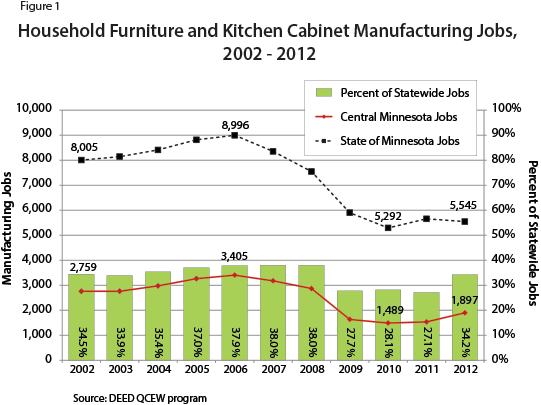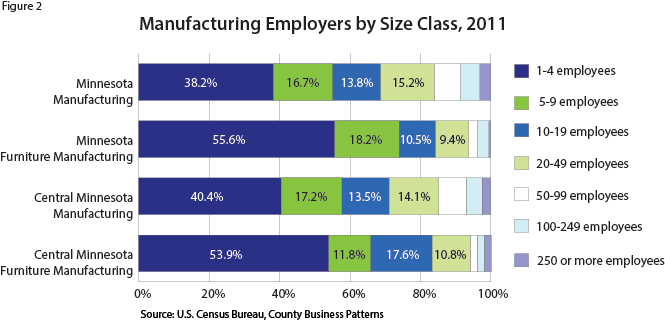by Cameron Macht
December 2013
Real estate agents say that a house feels empty until there is furniture in it, and then it feels more like a home, making it easier to sell. Central Minnesota is home to more than one-fourth of the state's employment in furniture and related product manufacturing, including one-third of the state's jobs in kitchen cabinet manufacturing.
Through 2012 the 13-county Central Minnesota planning region was home to 122 Furniture and Related Product Manufacturing establishments, providing 2,285 covered jobs and just under $94 million in total payroll. The largest segment in the region is Household and Institutional Furniture and Kitchen Cabinet Manufacturing, which provided 1,897 jobs at 108 firms with a payroll of $74.4 million. The region also has a small but significant concentration of employment in Office Furniture Manufacturing, offering 388 jobs at 14 firms (Table 1).
| Central Minnesota Industry Employment Statistics, 2012 | ||||||
|---|---|---|---|---|---|---|
| NAICS Industry Title | NAICS Code | 2012 Annual Data | ||||
| Number of Firms | Number of Jobs | Percent of Statewide Jobs | Total Payroll | Average Annual Wages | ||
| Total, All Industries | 0 | 17,479 | 254,123 | 9.6% | $9,270,803,237 | $36,452 |
| Furniture and Related Product Manufacturing | 337 | 122 | 2,285 | 26.5% | $93,647,713 | $40,976 |
| Household and Institutional Furniture and Kitchen Cabinet Manufacturing | 3371 | 108 | 1,897 | 34.2% | $74,410,703 | $39,208 |
| Office Furniture (including Fixtures) Manufacturing | 3372 | 14 | 388 | 15.2% | $19,237,010 | $49,556 |
| Source: DEED Quarterly Census of Employment & Wages (QCEW) program | ||||||
In the first half of the last decade demand for furniture and kitchen cabinets heated up along with the red-hot housing market, especially in Central Minnesota. From 2002 to 2006 total employment in kitchen cabinet manufacturing grew twice as fast in Central Minnesota (+23.4%) as in the state of Minnesota as a whole (+12.4%), with the Central region accounting for 38 percent of statewide employment at the high point of the industry in 2006.
But as the housing market cooled off, the craving for kitchen cabinets also went cold. From the peak in 2006 to the trough in 2010, Central Minnesota sliced more than 56 percent of its jobs in Household Furniture and Kitchen Cabinet Manufacturing, while the state lost 41.2 percent. Office furniture manufacturers rolled back more than one-third of their jobs in the state (-33.7%) and one-fourth of the jobs in the region (-27.7%).
As the housing industry has recovered and building has restarted, Kitchen Cabinet Manufacturing has started to simmer again. Jobs in Central Minnesota jumped 27.4 percent from 2010 to 2012, which was more than five times as fast as the state as a whole, which gained 4.8 percent (Figure 1).

Despite the recent gains, the Household and Institutional Furniture and Kitchen Cabinet Manufacturing sector still has only two-thirds of the jobs it started with in 2002 and would need to add almost 1,500 more jobs to get back to the employment peak reached in 2006. That would require several years of unprecedented growth — the region gained less than half that many jobs from 2002 to 2006 — and simply may never be attained again.
However, the sector has already outperformed DEED's Employment Projections for the next decade. According to DEED's industry projections, the Household and Institutional Furniture and Kitchen Cabinet Manufacturing sector was expected to grow from 1,490 jobs in 2010 to 1,730 jobs in 2020, but as shown above, was already closing in on 1,900 jobs in 2012. If the sector keeps adding jobs at the current rate — just over 200 net new jobs per year — it would surpass the previous record in 2019.
Job growth in Office Furniture Manufacturing was much more measured in the last two years, increasing by just 1 percent in Central Minnesota and 6.2 percent statewide. But the Office Furniture Manufacturing sector is expected to see much faster growth in the next decade, expanding as much as 40 percent through 2020, which would bring it back to the previous employment peak.
Long term, the fate of the industry is closely tied to the housing market, so more ups and downs are likely on the way. Job growth may heat up again as people start moving and building new houses or remodeling their kitchens, or employment may level off or drop again if they stay in place (Table 2).
| Central Minnesota Industry Employment Projections, 2010 to 2020 | |||||
|---|---|---|---|---|---|
| NAICS Industry Title | NAICS Code | Estimated Employment 2010 | Projected Employment 2020 | Percent Change 2010 - 2020 | Numeric Change 2010 - 2020 |
| Total, All Industries | 0 | 281,615 | 333,237 | +18.3% | +51,622 |
| Furniture and Related Product Manufacturing | 337 | 1,875 | 2,270 | +21.1% | +395 |
| Household and Institutional Furniture and Kitchen Cabinet Manufacturing | 3371 | 1,490 | 1,730 | +16.1% | +240 |
| Office Furniture (including Fixtures) Manufacturing | 3372 | 385 | 540 | +40.3% | +155 |
| Source: DEED 2010 to 2020 Employment Projections | |||||
Not surprisingly, many Household and Institutional Furniture and Kitchen Cabinet manufacturers responded to the downturn by downsizing their operations. In 2006 there were an average of 26 employees at each of the 133 Household and Institutional Furniture and Kitchen Cabinet Manufacturing establishments in Central Minnesota and 30 employees at each of the 18 Office Furniture Manufacturers. By 2010 the average firm had downsized to 14 and 24 employees, respectively, while the number of firms dropped to 107 and 14, respectively.
Most of the remaining furniture manufacturers are small businesses, including 83.3 percent that have less than 20 employees, and 53.9 percent that had between one and four employees. Instead, only four furniture manufacturers in the region had 100 or more employees, with three of those building kitchen cabinets and the other building office furniture (Figure 2).

Fortunately, the remaining employees are accustomed to the cutting, having been trained to cut, saw, and finish furniture and cabinets. Job seekers may be interested because many of the jobs still available in the sector require a high school diploma or less and short- to moderate-term on-the-job training, yet pay above average wages and have above average growth rates.
More than half of the top occupations in demand are projected to grow faster than average in Central Minnesota, including the five occupations most closely tied to the industry: upholsterers, sawing machine operators, woodworking machine operators, carpenters, and cabinetmakers and bench carpenters.
As an example, cabinetmakers and bench carpenters earn a median hourly wage of $16.86 in Central Minnesota, compared to $16.14 for the total of all occupations, and are expected to grow 31.5 percent from 2010 to 2020, which is 13 percent faster than the total of all occupations. Entry-level cabinetmakers and bench carpenters typically need a high school diploma or equivalent, as well as three months to one year of on-the-job training.
Nine of the top 10 occupations in demand in both the Household and Institutional Furniture and Kitchen Cabinet Manufacturing sector and the Office Furniture Manufacturing sector can be gained with a high school diploma or less, with the lone exception being first-line supervisors of production workers, which often also require some sort of postsecondary non-degree award as well as related work experience (Table 3).
| Occupations in Demand in Furniture and Related Product Manufacturing in Central Minnesota | ||||||||
|---|---|---|---|---|---|---|---|---|
| Occupational Title | Median Hourly Wage | Estimated Regional Employment 2010 | Projected Regional Employment 2020 | Percent Change 2010 - 2020 | Numeric Change 2010 - 2020 | 2010 - 2020 Replacement Openings* | Education Requirements | On-the-job Training Requirements |
| Total, All Occupations | $16.14 | 281,615 | 333,237 | +18.3% | +51,622 | +66,890 | ||
| Cabinetmakers and Bench Carpenters | $16.86 | 482 | 634 | +31.5% | +152 | +120 | High school diploma or equivalent | Moderate term on-the-job training |
| Assemblers and Fabricators, All Other | $13.23 | 1,304 | 1,711 | +31.2% | +407 | +260 | High school diploma or equivalent | Moderate term on-the-job training |
| Carpenters | $20.90 | 2,107 | 2,745 | +30.3% | +638 | +450 | High school diploma or equivalent | Apprenticeship |
| Welders, Cutters, Solderers, and Brazers | $17.90 | 1,276 | 1,648 | +29.2% | +372 | +340 | High school diploma or equivalent | Moderate term on-the-job training |
| Woodworking Machine Operators | $13.99 | 316 | 393 | +24.4% | +77 | +30 | High school diploma or equivalent | Short term on-the-job training |
| Sawing Machine Operators | $16.04 | 163 | 201 | +23.3% | +38 | +40 | High school diploma or equivalent | Short term on the job training |
| Laborers and Freight, Stock, and Material Movers, Hand | $12.09 | 2,960 | 3,602 | +21.7% | +642 | +950 | Less than high school | Short term on-the-job training |
| Upholsterers | $14.56 | 96 | 116 | +20.8% | +20 | +20 | High school diploma or equivalent | Moderate term on-the-job training |
| Sales Representatives, Wholesale and Manufacturing | $26.96 | 2,228 | 2,612 | +17.2% | +384 | +520 | High school diploma or equivalent | Moderate term on-the-job training |
| Furniture Finishers | $8.83 | 39 | 45 | +15.4% | +6 | +10 | ||
| Industrial Truck and Tractor Operators | $16.99 | 842 | 970 | +15.2% | +128 | +240 | Less than high school | Short term on-the-job training |
| Helpers-Production Workers | $11.00 | 784 | 893 | +13.9% | +109 | +130 | Less than high school | Short term on-the-job training |
| First-Line Supervisors of Production Workers | $24.97 | 1,650 | 1,863 | +12.9% | +213 | +220 | Postsecondary non-degree award | None |
| Cutting, Punching, and Press Machine Operators | $14.44 | 909 | 1,026 | +12.9% | +117 | +70 | High school diploma or equivalent | Moderate term on-the-job training |
| Team Assemblers | $14.71 | 2,066 | 2,300 | +11.3% | +234 | +410 | High school diploma or equivalent | Moderate term on-the-job training |
| Shipping, Receiving, and Traffic Clerks | $14.91 | 1,210 | 1,311 | +8.3% | +101 | +310 | High school diploma or equivalent | Moderate term on-the-job training |
| Sewing Machine Operators | $10.75 | 139 | 143 | +2.9% | +4 | +10 | Less than high school | Short term on-the-job training |
| Source: Bureau of Labor Statistics, DEED Occupational Employment & Wage Statistics (OES), DEED 2010-2020 Employment Projections | ||||||||
A high school education and one year of training can get a worker in the door, but new technology and more sophisticated machinery require workers to continue with their training. Becoming a skilled woodworker often takes three or more years, with workers needing to read blueprints, set up machines, and plan work sequences.
According to the Bureau of Labor Statistics' Occupational Outlook Handbook, "people seeking woodworking jobs can enhance their employment and advancement prospects by completing high school and getting training in computer applications and math."1
"Skill with computers and computer-controlled machinery is increasingly important. Those who have advanced skills, including in mathematics and computers, should have the best job opportunities in manufacturing industries."2Job analysis shows that some woodworkers further their education at technical schools or community colleges, while others attend postsecondary training in wood technology, furniture manufacturing, wood engineering, and production management, all of which become more important as woodworking technology advances.